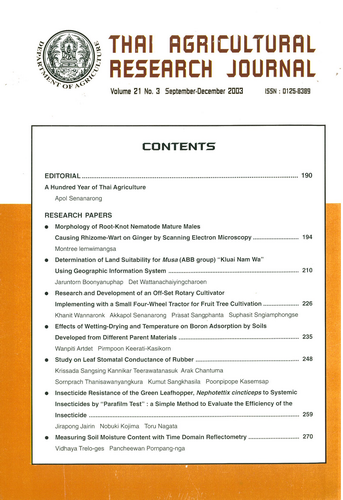Morphology of Root – Knot Nematode Mature Males Causing Rhizome – Wart of Ginger by Scanning Electron Microscopy
DOI:
https://doi.org/10.14456/thaidoa-agres.2003.15Keywords:
ginger, rhizome, disease, root-knot nematod, Meloidogyne javanica, male, SMEAbstract
Several stages of root – knot nematodes were collected from rhizome-wart disease of ginger (Zingiber officinale Rosc.). The morphological character of males were identified to be Meloidogyne javanica by the shape of the head, cephalic organ, stylet length and shape of basal knobs and the distance of the dorsal gland orifice from the base of knobs with the transparency light microscopy (TLM). The scanning electron microscopy (SEM) could distinct the male skin or cuticle showing shape of the head, annulation and the number of incisures and the ridge in the lateral field. One hundred males of Meloidogyne spp. From the area of root-knot nematodes infestation ginger soils in Chiang Rai province were collected and studied with SEM. The observations and identification were specified on head structure, body with lateral field and tail to be M. javanica. The steps of fixation, dehydration, drying, mounting, coating and SEM observation were clearly in the process. Photos were illustrated high, wide head cap with stoma and labial sensila, shape and proportion of labial disc and median lips, and protruding sharp tip stylet. The lateral field that begins as a ridge originates at 11th body annule from the head region and fuse completely around the tail tip. The excretory pore and phasmids are not visible. The cloacal opening showed two spicules.
Downloads
Published
How to Cite
Issue
Section
License

This work is licensed under a Creative Commons Attribution-NonCommercial-NoDerivatives 4.0 International License.
Thai Agricultural Research Journal



